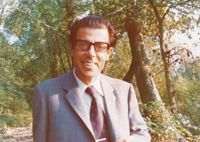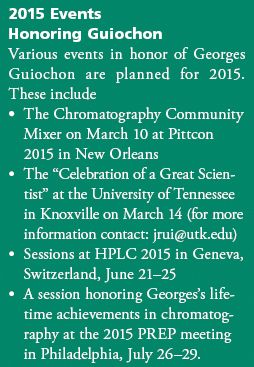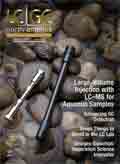In Memoriam: Professor Georges A. Guiochon
LCGC North America
On October 21, 2014, University of Tennessee Distinguished Scientist Georges Andre Guiochon succumbed to neuromuscular failure caused by post-polio syndrome. Here, we pay tribute to his remarkable career and life.
On October 21, 2014, University of Tennessee Distinguished Scientist Georges Andre Guiochon succumbed to neuromuscular failure caused by post-polio syndrome. Here, we pay tribute to his remarkable career and life.
Georges Andre Guiochon was enthusiastically interested in broad areas of separation science from preparative to analytical chromatography. He probed deeply and elucidated fundamental and practical principles based on studies ranging from isotherms in preparative chromatography, mechanisms of liquid chromatography (LC), and gas chromatography (GC) to two-dimensional (2D) and three-dimensional (3D) LC. He developed the theory of nonlinear chromatography and applied it to GC, LC, and supercritical fluid chromatography (SFC). Georges's last years were spent in the pursuit of understanding SFC and core–shell particle performance.

Early Career in France
Georges was born in Nantes, France, on September 6, 1931. He attended Ecole Polytechnique in Paris where he received the degree of Ingenieur after having spent a year hospitalized with polio that rendered him unable to walk. His remarkable determination prevailed, and he walked and went on to receive a PhD in chemistry from the University of Paris. At the request of the French military, his work on the cause of explosions involving ammonium nitrate remained confidential for decades although his counsel on the safe handling of that compound is posted in factories where it is produced. It was only in 1995, after U.S. officials investigating the bombing of a federal building in Oklahoma went to the Oak Ridge National Laboratory to seek his advice, that Georges felt free to share his knowledge. Later, after an explosion in a manufacturing facility in Toulouse, France, Georges was called upon as an expert witness in the court trial and the appeal.
Georges's career in France was outstanding and yielded many awards and public accolades, including two Tswett medals (Advances in Chromatography and the Academy of Sciences of USSR), the Stephen Dal Nogare Award, the AJP Martin Medal, a Silver Medal from the Centre National de la Recherche Scientifique, and a JSPS Fellowship for Research in Japan. Initially, his work focused on the fundamentals and application of GC, but later he became involved in the development of high performance liquid chromatography (HPLC). Georges moved into the elevated position of Director of Chemistry and Physics at the Ecole Polytechnique as well as that of Professor at the University of Paris. Aside from his publications and publicly known activities, Georges was again drawn into confidential work involving locating the sites in southern France where heroin was being produced by reacting opium and acetic anhydride. He applied his analytical chemistry skills to assist officials in thwarting the French Connection, a subject he was loath to reveal.
Family
During this time, Georges and his wife Claudine raised three daughters. The oldest, Anne, became a physician with a doctorate in molecular biology. She is a leader at a medical university. Alice, the second daughter, majored in computer science and now supervises a large team of experts. The youngest, Odile, is an economist overseeing a staff in an insurance company. Along with their successful careers, his daughters and their husbands produced seven grandchildren. Georges's second wife, Lois Ann Beaver, who worked at the Food and Drug Administration (FDA), is extremely happy to be close to such a vibrant family.
Work and Achievements in the U.S.
In 1984, Georges accepted an invitation to be a Professor of Chemistry at Georgetown University in Washington, DC. Three years later, he agreed to become a Distinguished Scientist with simultaneous positions at the University of Tennessee in Knoxville and at Oak Ridge National Laboratory. Georges was pleased with the computer access and the instrumentation he acquired. Many students sought to study under him. This period was especially productive, leading to many innovations and basic studies in chromatography and separation science.

2015 Events Honoring Guiochon
The recognition earned by Georges during this period is extraordinary, and his awards are too numerous to list. We note two American Chemical Society awards: the ACS Award in Chromatography and the ACS Award in Separation Science. Other prestigious awards include the LCGC Lifetime Achievement Award, the Horvath Medal, the István Halász Award, the von Humboldt Award, and more. Georges received honorary doctorates from the Technical University in Budapest, Hungary, in 1982; the University of Pardubice, in the Czech Republic, in 1999; Ramon Llull University in Barcelona, Spain, in 2002; the University of Ferrara, in Italy, in 2003; and the University of Science and Technology Laoning, in China, in 2010. He was inducted into both the Catalonian and the Spanish Academies of Science in 2011. He was a permanent member of the HPLC conference series committee and in 1985 became associated with the PREP Symposium, which is still a vibrant conference covering developments in preparative and nonlinear chromatography.
Georges's research culminated in the publication of more than 1200 papers. Given this impressive achievement, Professor Peter Carr of the University of Minnesota suggested that the number of research papers published should be standardized in units of "the Georges" (G), with 1 G = 1000 papers. If you published 120 papers you would have published 0.12 G or 120 milliGeorges of papers.
Georges published seven books: A Guide to the HPLC Literature, Vol. 1 (1966–1979), Vol. 2 (1980–1981) and Vol. 3 (1983) all with coauthors J.-L. Excoffier, H. Colin, and A.M. Krstulovic; Gas Chromatography in Inorganics and Organometallics with C. Pommier in 1971; Quantitative Gas Chromatography with C.L. Guillemin in 1988; Fundamentals of Preparative and Nonlinear Chromatography with S. Golshan-Shirazi and A.M. Katti in 1994 (an updated edition, published in February of 2006 also includes A. Felinger); and Modeling for Preparative Chromatography with B.C. Lin in 2003. The book on preparative and nonlinear chromatography is considered the definitive work in this area and is affectionately known as "Bob" (the Big Orange Book).
Georges taught more than 100 graduate students and post-docs and is considered one of the major leaders in chromatography research of the past 50 years. Many of his students are employed by industrial, academic, and national laboratories throughout the world in fields as diverse as the pharmaceutical industry, chromatography and separation science research, chromatographic equipment, and business.
His presence in the field of chromatography was evidenced by numerous invitations to speak at scientific conferences. Georges was immersed in chromatography like few others have been, could be, or will be. He was a brilliant researcher who mentored hundreds of people, not only in the university environment but also in the context of the PREP and HPLC meetings. At these meetings Georges had an entourage of people, including friends, fellow researchers, students, and those who had technical questions for him. When asked, Georges would say his motivations were "understanding phenomena, solving problems and training people." This was evident right to the end.
Fond Memories of Georges
In addition to being a great scientist, Georges was a unique individual. His love of king crab is legendary. When in Chicago, Georges and Lois would seek accommodations across the street from Joe's Stone Crab Restaurant, so that he could eat nearly every meal there. Georges's knowledge of great restaurants follows in the tradition of the French. If you found him in a restaurant, you knew it was a good choice.
Georges loved his family, and he and Lois spent considerable time with them exploring different countries and showing them the United States. His knowledge of history was remarkable. Georges followed the entire Lewis and Clark trail and especially studied geologic phenomena caused by ice age flooding of Lake Missoula.
Although attending conferences was not always easy for Georges, he did so regularly, because he enjoyed interacting with his scientific colleagues. Often he would be pleased with the talks he heard, but occasionally he would show disdain. When Georges challenged a presenter it was because he was concerned that a young and developing scientist might be misled.
He remarked that István Halász, a famous Hungarian chromatographer and the PhD advisor to Csaba Horváth, maintained that very high pressures were unnecessary for extremely high performance separations. When core–shell particles were shown to demonstrate this, Georges was pleased. He had a deep understanding of how chromatography functions and explained matters in clear, understandable terms. Georges's work is widely referenced not only by chromatographers, but also by applied physics and fluid mechanics researchers, chemical engineers, and biochemists interested in the mechanics of separations. He was prolific in the subject matters, angles, and approaches he took to separation science.
Georges was unrelentingly generous with his time in mentoring separation scientists who demonstrated great potential. He would often praise their accomplishments and felt he had a responsibility to usher them into the chromatography community.
With Georges's passing, we have lost a great person and a great scientist. We can be comforted, however, by knowing that Georges's legacy will continue to inspire future advances.
Mark R. Schure is chief technology officer with Kroungold Analytical in Blue Bell, Pennsylvania. Lois Ann Beaver (Guiochon) is retired from the Food and Drug Administration. Direct correspondence to: mark.schure@gmail.com

Measuring Vitamin K1 Concentrations in Dogs with Chronic Enteropathy Using LC–MS/MS
May 14th 2025A joint study between the University of Tennessee (Knoxville, Tennessee) and the University of Pennsylvania School of Veterinary Medicine (Philadelphia, Pennsylvania) compared directly measured vitamin K1 (vitK1) concentrations in healthy dogs and dogs with chronic enteropathy (CE) using liquid chromatography tandem mass spectrometry (LC–MS/MS); they also investigated whether supplementation of vitK1 in dogs with CE would significantly increase vitK1 concentrations.
HPLC 2025 Preview: Fundamentally Speaking (Part 2)
May 14th 2025Michael Lämmerhofer from the Institute of Pharmaceutical Sciences, University of Tübingen, Germany, spoke to JFK Huber Lecture Award winner of 2024 Torgny Fornstedt, professor in analytical chemistry and leader of the Fundamental Separation Science Group, Karlstad University, Sweden, about his pioneering work in high performance liquid chromatography (HPLC) with a focus on fundamentals, ion-pair chromatography, and oligonucleotide applications.

.png&w=3840&q=75)

.png&w=3840&q=75)



.png&w=3840&q=75)



.png&w=3840&q=75)












